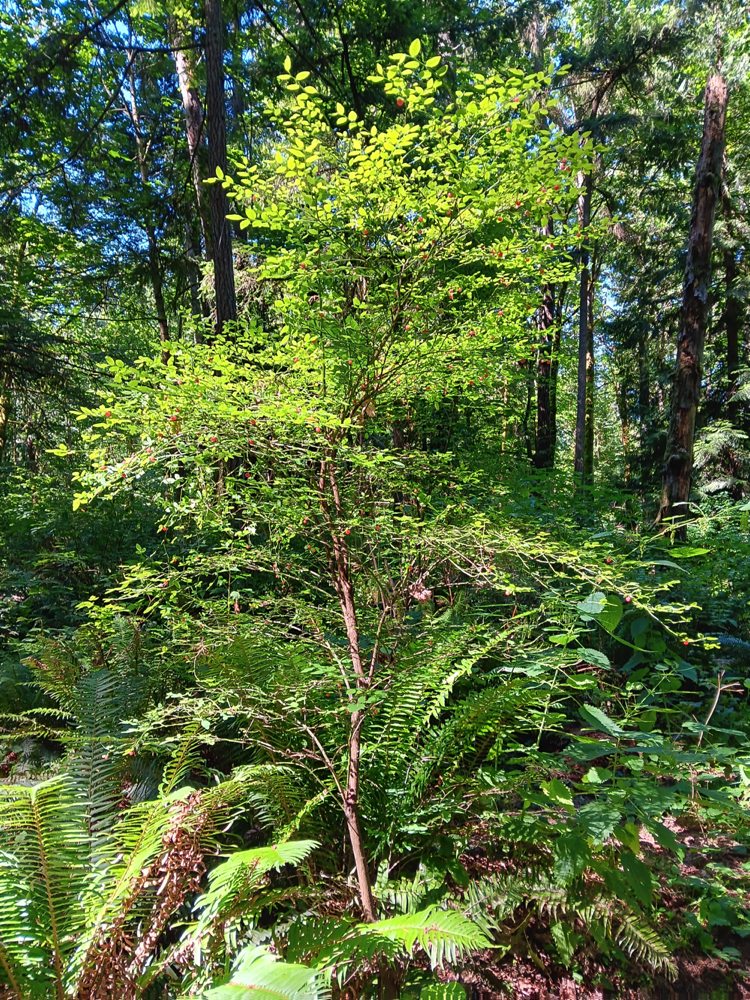
by Marilee Henry

Red huckleberry is a deciduous upright shrub commonly found in dense to open woodlands of mixed conifers and evergreens from sea level to mid elevations in the western mountains and coastal regions of Alaska to northern California. Often growing on old tree stumps, nurse logs, or other decaying woody material, bright-green bare branches studded with pink leafbuds provide a stunning contrast in the forest understory in late winter to early spring. The bright green leaves of summer become interspersed with small cherry-red berries that ripen between July to August, and may persist into fall. And as winter approaches, the branch tips and old leaves may turn reddish, mixing scarlet with its green hues.
This graceful shrub normally grows from 4 to 12 feet in height with a spread of about 5 feet, has attractive prominently-angled stems and branches, alternate smooth-edged leaves about 1 inch in length, small urn-shaped creamy-pinkish flowers from April to May, and berries that later form singly in the leaf axils. A closely related species, grouseberry (V. scoparium), is found near the Cascade crest and in eastern Washington generally at higher elevations and in drier habitats. It is distinguished from red huckleberry (V. parvifolium) by shorter height of 1 foot or less, smaller and slightly toothed leaves, and smaller bright red berries.
Along with being a prized garden ornamental, red huckleberry is highly valued for wildlife. Its delicious edible berries attract many species of birds, raccoons, foxes, bears, chipmunks, and other animals. The foliage is browsed by deer, elk, mountain goats, and other mammals. The nectar and pollen attract bees, bumblebees, hummingbirds, and butterflies. Bumblebees and some species of solitary bees (but not honeybees) are able to gather tightly held pollen from its unusually shaped anthers using "buzz pollination"; the bee's flight muscles vibrate at certain frequencies (the average is around 270 cycles per second, which is near middle C on a piano) to more efficiently release the pollen! Interestingly, about 9% of all flowering plants rely on buzz pollination.
Most importantly, according to the National Wildlife Federation, the genus Vaccinium, which includes blueberries, huckleberries, cranberries, and lingonberries, hosts the larvae of 149 species of moths and butterflies in our region, including the green comma butterfly and polyphemus moth.
Why do I keep writing about the importance of larvae?
Because the larvae of moths, and to a lesser extent of butterflies, are so critical to the survival of many birds and other species.
According to this excellent hour-long video lecture on moths, their biomass is a significant part of the base of the pyramid that feeds our planet's other animals! In the case of birds, a breeding pair with four baby chicks cannot supply enough high-density food for them all to survive unless they have moth larvae available. Seeds from backyard bird feeders simply cannot supply the same amount of quality calories and nutrients.
Loss of native plants and habitats necessary for moth/butterfly larvae survival are limiting that critical food supply and are one of the major reasons why bird populations have been in alarming decline. All of us can help rectify this crisis by planting a diversity of natives in our gardens that host the larval stages of these insects.
Note that the butterfly bush (Buddleja sp.) does not host moth or butterfly larvae. Read here how these shrubs are actually harmful to birds.
Red huckleberries are also relished by indigenous peoples. The slightly tart but tasty berries are high in antioxidants and vitamin C and reportedly make great preserves. Historically the berries were eaten in many recipes, their leaves could be seeped for a tea, a decoction of bark treated colds, and branches were used for brooms. Resembling salmon eggs, the berries could be used for fish bait. And today's outdoor enthusiasts eagerly snag berries as a refreshing snack along the trail.
The ideal setting for red huckleberry in an urban garden is in partial sun among native evergreens such as Douglas fir, red cedar, or hemlock in humus-rich slightly acidic soils amid decaying woody debris. Low Oregon grape, salal, and rhododendron make good companion plants. Though tolerant of deep shade, fruit will be more abundant on plants grown in partial morning sun and when planted within about 50 feet in line of sight of another of its kind. This spacing is not too far for pollen-laden bees to fly between them in a single run, and will likely result in cross-pollination producing more berries and more vigorous seeds. Plants should be watered regularly till well established (the first two years), and then deeply but infrequently when dry. It is recommended to keep them well mulched and away from footpaths as their roots do not tolerate compaction.
Early winter is a good time to plant natives, before the ground gets too frozen to dig. It also gives dormant plants time to put their energies into robust root development, which will enhance their survivability during the heat of the coming summer.
Let's celebrate the start of 2025 by planting natives!
Remember, "You are nature's best hope!" - Doug Tallamy, author of "Nature's Best Hope" and "Bringing Nature Home".
Marilee Henry
Kirkland Community Wildlife Habitat Team Member, Washington Native Plant Society (WNPS) Native Plant Steward, Green Kirkland Steward, Finn Hill Neighborhood Alliance Contributor
Snohomish Conservation District
Online ordering starts at 9:00am on Jan 6 through Feb 7, 2025
Pickup at Evergreen State Fairgrounds, Monroe, March 1-2, 2025
https://www.wnps.org/native-gardening/plant-sales
Monitor this site for upcoming plant sales and resources for 2025